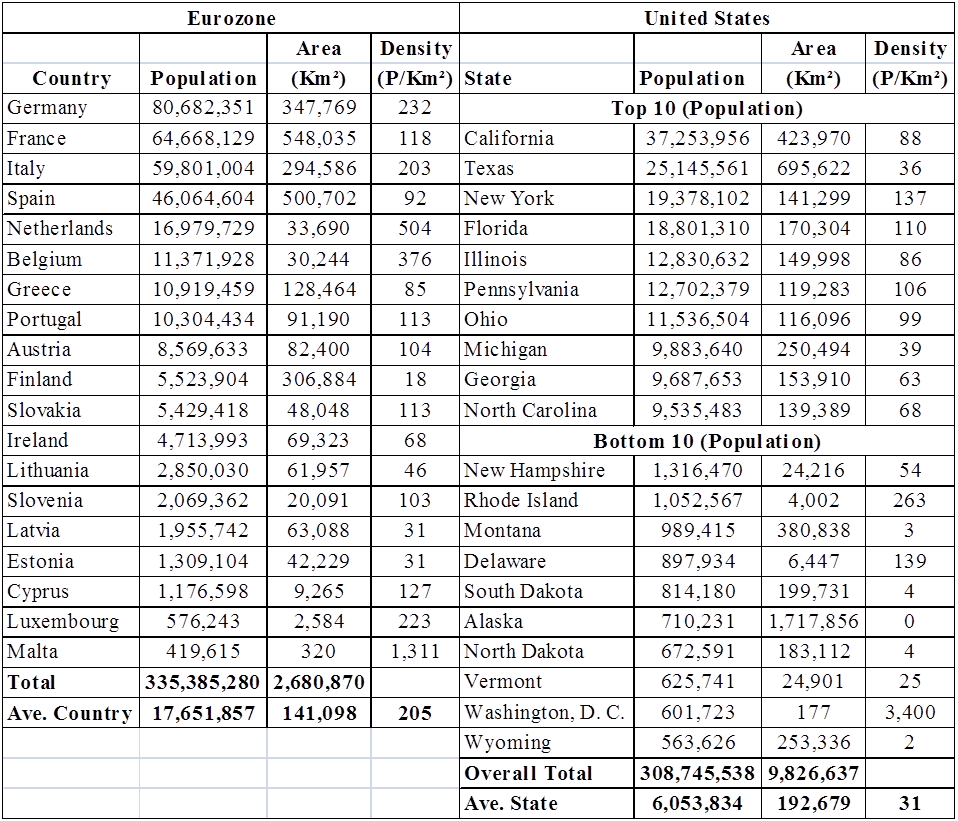Introduction
Ever since I started covering the plight of Greece in 2010, I have believed that the ultimate resolution for Greece and other “weak sister” countries would be to go back to their own currencies. Why? The short answer: depreciation of their own currencies would compensate for productivity differences between them and countries using the euro. And here, there is an analogy with the US and Japan. To neutralize Japan’s productivity edge in the ‘70s, the dollar has weakened from more than ¥300 to the current 100¥ to the dollar.
However, many cannot follow this logic. So below, I compare US states with Eurozone countries. The comparison is apt inasmuch as US states use the same currency just as all Eurozone countries use the Euro. Table 1 provides the “basics” on the two country groupings. For the US, only the ten largest and smallest states (measured by population) are included.
Basic Data
The populations of the two regions are quite similar. But the US area is more than three times larger than the Eurozone and consequently has a much lower overall population density. The “average” Euro country has more people and less land than the “average” US state.
Table 1. – Eurozone Countries and US States: Populations, Areas and Densities
Economic Differences
Table 2 provides data on unemployment differences between Eurozone countries and the ten US states with the highest and lowest unemployment rates. The unemployment differences within each region are striking. Unemployment in Greece is 24% and 6% in the “strong” Euro countries. In the US, the spread is only 3.9% (2.8% to 6.7%) compared to the Eurozone range of 19.2%. What explains these differences? Migration: in the US, when there is an “oil boom” in North Dakota, laborers looking for work go to North Dakota. This does not happen in the Eurozone.
Table 2. – Eurozone Countries and US States: Unemployment Rates

“The Eurozone has about 330 million people, so very similar to the United States in total size. Its combined migration over major internal borders and from the rest of the world came to about 4 million people in 2012, or 1.2% of the population. In the US, the same statistic would be about 5–9 million people, or 2.5–4%, depending on how you define comparable internal borders.
In other words, record-high migration in the Eurozone is still only about half the level of migration in the United States. So when we think about migration in these countries, we need to keep in mind that even very large gross migrant flows by European standards are on the smallish side by US standards. Europe has not yet begun to experience genuinely high rates of internal or international migration. Those high rates continue to be the fairly exclusive territory of “settler” countries like the US and Australia, as well as some rapidly-developing countries or countries with nomadic populations.”
The Consequences
With limited migration and no ability via currency changes to correct for productivity differences, what will happen to the “weak sister” countries in the Eurozone? Greece is a good example: they will run out of Euros. More specifically, because of cost differences, they will buy more products from other countries than they will sell. This will draw down their Euro balances. They will start to borrow to finance their trade deficits to a point where they can borrow no more.
Table 3 provides trade balance and debt data for Eurozone countries. Countries with debt over 100% of GDP with negative trade balances are worrisome. They already have high debt and their trade deficits means that they will soon “run out of money.” And of course, Greece’s situation is hopeless unless it can get out of the Eurozone.
Table 3. Debt and Trade Balances of Eurozone Countries

And of course, there is the sticky “security” migration issue that applies to all European Union countries. The rules of the European Union (EU) enshrine the free movement of people. The “Schengen Agreement”, (199 eliminated border checks among its members and allowed foreign visitors to travel throughout the area using one visa. Today, a total of 26 states, both within or outside the EU, are members (see map).
The growing concerns over security and Middle East migrants are placing great strains on the agreement. And already, a number of EU countries have overridden Schengen and placed their own limits on migratory flows. It is unclear where this will lead.
Conclusions
Above, an attempt has been made to show why the Eurozone will probably break up. And beyond that, the very existence of the European Union is threatened by security and increased migratory inflows.

